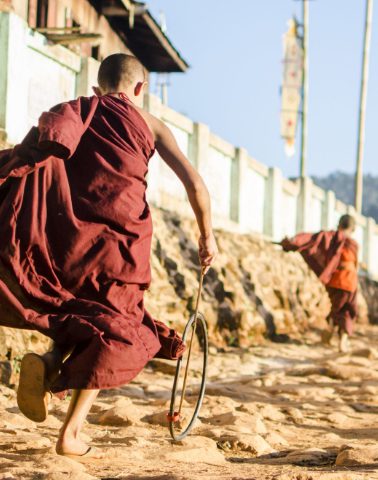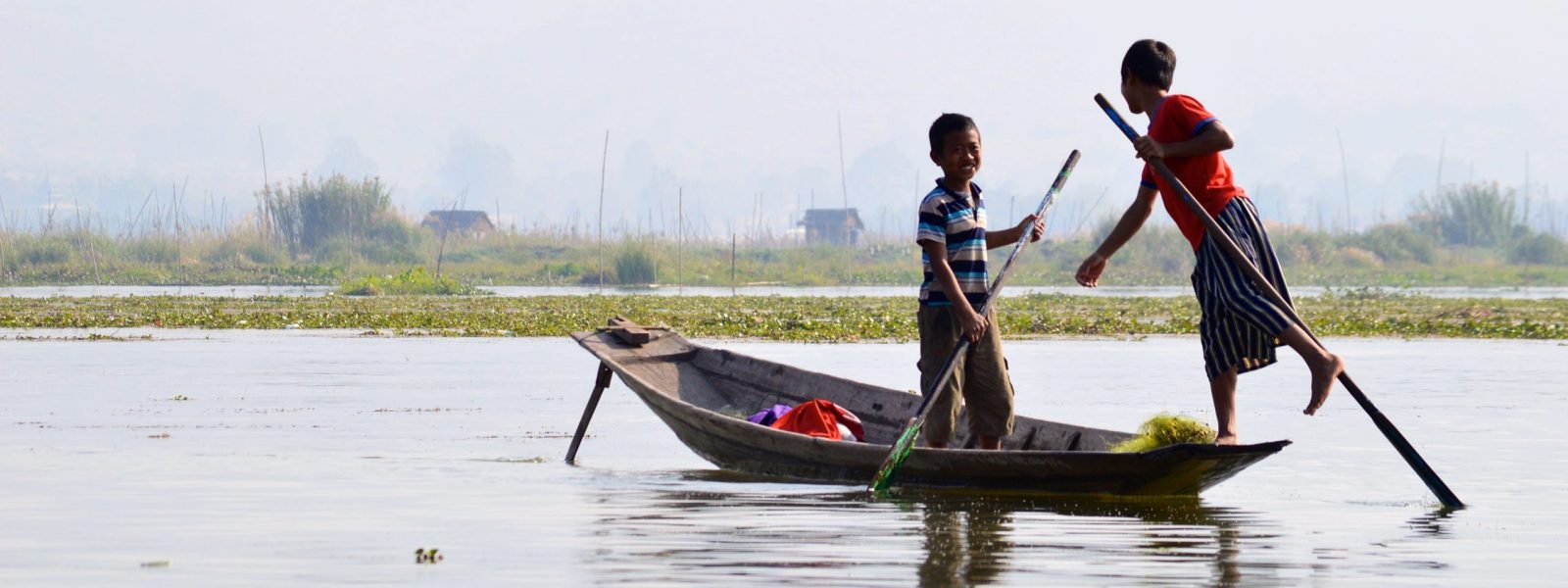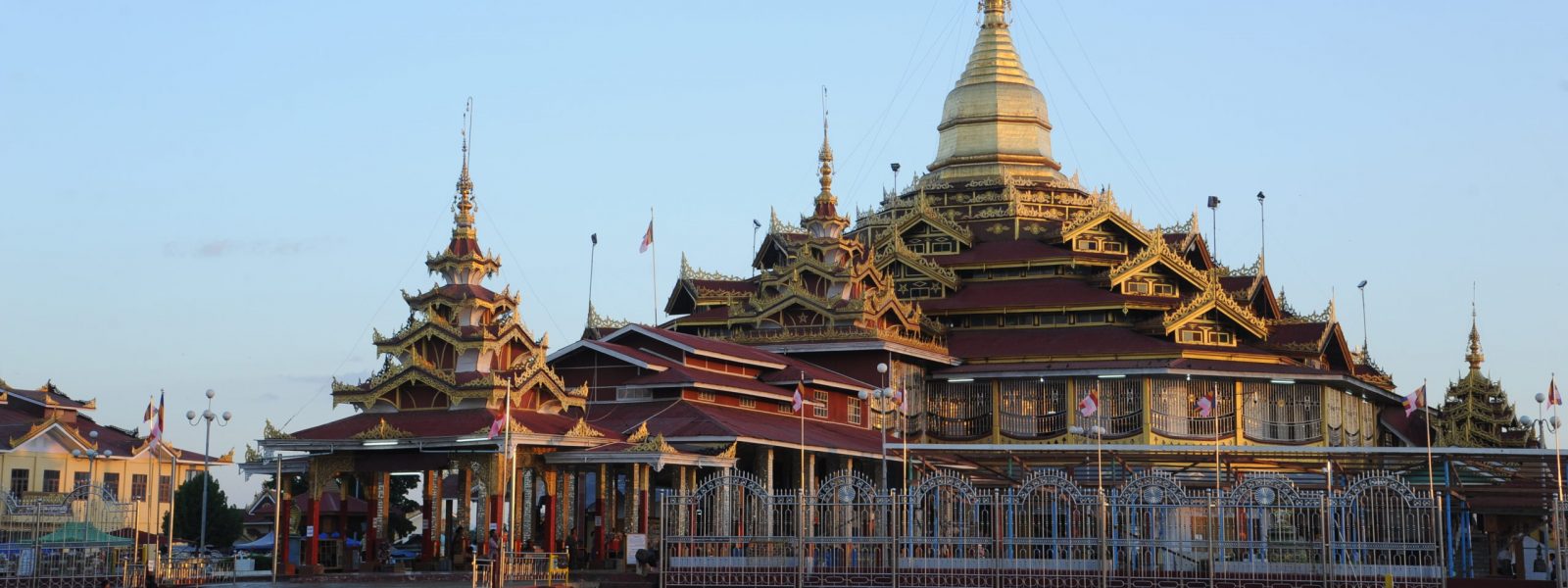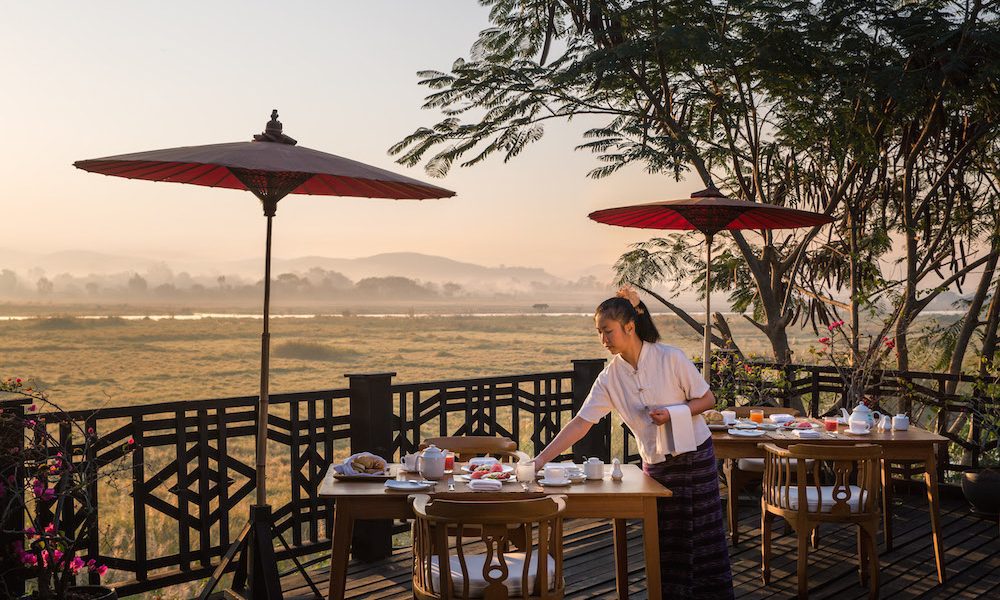
Subscribe to our mailing list
We are still here! Let us send you tips for travelling through Myanmar and stories from the road …
The inhabitants of Inle are the Inthar and when wondering what to do at Inle Lake, there is no better start to the day than waking up before dawn for an Inle Lake boat trip to see the fishermen as the sun rises.
Due to the similarity of the two vernaculars, the provenance of the Inthar is believed to be the southern city of Dawei. Legend tells of two Inthar brothers who came up to the lake in 1359 to serve the local Shan sabwa or ‘sky lord’. The sabwa was so impressed with the diligence and character of the two brothers that he invited a further 36 families from Dawei to emigrate north and populate the lake. A more prosaic theory is that the Inthar were not economic migrants but in fact refugees from Dawei, fleeing to Shan to avoid the Bamar-Siam wars.

The Inthar’s idiosyncratic way of fishing has propelled the Inthar across postcards and tour brochures. Today, after the ephemeral stupas of Bagan, the image of an Inthar fisherman balancing deftly on his boat, one leg wrapped around the rudder, the other outstretched for balance, two arms grasping the net and a conical hat topping off the elegant silhouette, is an image used more than any other to conjure the allure of the Golden Land.
Dawn is also prime time for keen twitchers. The lake has been an official Wetland Bird Sanctuary since 1985 and thus activities such as morning bird watching tours have become increasingly popular things to do on Inle Lake for travellers. Alongside the clamorous reed warbler, early risers may be lucky enough to catch sight of rarer species such as Jerdon’s bushchat, the collared myna, and the crimson sunbird.
Before continuing your Inle Lake boat trip you can return to your hotel for a well-deserved breakfast. Looking across the lake and its banks you will see smoke tendrils ascending from village kitchen fires and hear the doleful ringing of bells that accompanies the monks and young novices on their morning alms collection.
As morning stretches into midday, recommence your Inle Lake tour by catching a boat to Phaung Daw Oo Pagoda. As your boat bobs up next to the pagoda jetty, the wrinkled hands of gentle crones will help you onto the platform and with few words offer bags of seeds for no more than tuppence to feed the myriad pigeons of Phaung Daw Oo.
(Note: Be sure to visit Phaung Daw Oo in the morning; in the afternoon the birds are fully sated and huddled in the rafters.)

Next, take the boat further into the marshes west to the small town of Indein for the 5 Day Rotating Market, commonly regarded as one of the most memorable things to do at Inle Lake. Here people of the Shan, Pa’O and Danu ethnicities come down to join the Inthar to sell and buy local produce. We would recommend picking up one of the bright and sturdy Pa’O tote bags that are seen throughout Shan State, sported by school children, chic teenagers and farmers alike.
When you have exhausted the market, explore the crumbling pagoda fields. Here one can creep through brambles and undergrowth to peer at ornately carved zedi and Buddha images sitting waist deep in rubble.
Subsequently one can continue south down to Lake Samkar, one of the less common things to do at Inle Lake. Samkar, Inle Lake’s southern twin, shares its name with an old Shan capital that was lost by its sabwa in a bet with the Prince of Inle centuries ago. Samkar (or “Sagar”), one of Myanmar’s many once mighty capitals, is today just a village where cows munch grass nonchalantly amongst exquisite stupas and statues.
Lunch can be enjoyed at the pictorial guesthouse Inle Sanctuary.
On your journey back to Inle Lake, less common things to do include stopping off at Tharkaung, an ancient pagoda field with zedi larger than those at Indein. Rarely visited by tourists, you will likely share the fields with no others but boys from the village who, between casting curious glances at you and your party, will concentrate their time on trying to knock fruit out of the trees.
Inthar boys will challenge the Inthu (‘daughters of the lake’) to a taik-tay, salving and gently teasing in rhyming stanzas that evoke the rites and rural traditions of the Inthar.
On the full moon or on Buddhist festivals such as Thadingyut and Tazadaung, the luckiest of travellers may catch a glimpse of the Inthar youth serenading to each other in traditional “taik-tay” duets. Much in the way that the land-lubbing Bamar youth use a pagoda festival as an excuse for flirting and clandestine promenades, so Inthar boys will challenge the Inthu (‘daughters of the lake’) to a taik-tay, salving and gently teasing in rhyming stanzas that evoke the rites and rural traditions of the Inthar.
Taik-tays do not appear in travel brochures, but they are as longstanding an aspect of Inthar culture as the conical hats and sampans. These more subtle conventions are not one of the promoted Inle Lake attractions and thus there is the risk that while that which can fit on a postcard will be sustained, the literature and even the language of the Inthar will gradually pass away.
The Inthar Heritage House is both restaurant and cultural centre and was established in 2009 by Yin Myo Su, manager of the Inle Princess Resort and daughter of the current Minister for Hotels and Tourism, U Ohn Maung. Here visitors can both take reviving refreshment and learn more about the Inthar people. The centre aims to preserve and promote the Inthar stories and conventions while at the same time promoting organic farming and conservation of the lake’s biodiversity.

Perhaps more than anywhere in Myanmar, the ecological well-being of Inle is under threat and the rapid acceleration of tourism to the region is placing more pressure on the fragile eco-system. Inle Lake now covers less than half of the area that it once did. Mining for gold has led to the release of pollutants into the river and the relatively recent use of chemical fertilisers and pesticides in the surrounding farms has intoxicated the water.
Furthermore, the introduction of alien fish has led to the demise in species unique to Inle. The Inle carp for example, has long been hybridizing with the common carp after the introduction of the latter. Today it is near impossible to find a pure Inle carp. This is what is referred to in biology as the ‘homogecene’, where what is unique and special collapses and wherever one goes the same fauna and flora is found.
The feared homogecene of Inle reflects a palpable anxiety in Myanmar that what is unique to the country is under threat due to globalisation. In addition to the Inthar, what for instance is to happen to the culture and conventions of the country’s 134 other ethnic groups? Is the best they can hope for to be placed on life support by the tourism industry?
Indeed, one does not even have to look as far as the ethnic minorities. As the country opens its doors up to the world, how long will the people of Myanmar as a whole continue to favour longyis, thanaka and green cheroots above Levi jeans, Dove face cream and Marlboro Lights?
It is here where projects such as Inthar Heritage House come into play.
… one can appreciate the beauty and rejoice at having the privilege to see it, while at the same time recognise its fragility.
Naturally, there are many boons that have and will continue to come to Myanmar through opening up to the world. The cross pollination of cultures can lead to fresh opportunities and the introduction of new tastes. For example, at Inle visitors can both take reviving refreshment and learn more about the Inthar people. Here, Inle Lake travellers can sample the four wines of Myanmar’s second ever vineyard while looking out upon the best view of Inle Lake that we know of. Such things, alien but complementary, could scarcely have been imagined in Myanmar a couple of decades ago.
As the sun sets on your 24 hour Inle Lake tour and the Inthar come out to fish once more, one can appreciate the beauty and rejoice at having the privilege to see it, while at the same time recognise its fragility. Like anything, such beauty must be nurtured tenderly to prosper for the benefits of all stakeholders, from the discerning tourist, to the fishermen, to the clamorous reed warbler and the Inle carp.